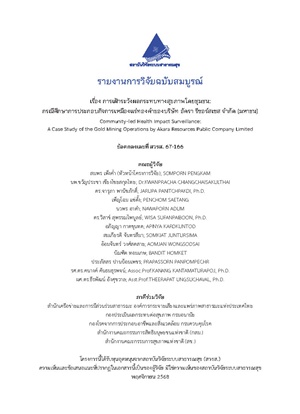บทคัดย่อ
การร้องเรียนของประชาชนเกี่ยวกับผลกระทบด้านสิ่งแวดล้อมและสุขภาพจากการประกอบกิจการเหมืองแร่ทองคำของบริษัท อัครา รีซอร์สเซส จำกัด (มหาชน) ตั้งแต่ปี พ.ศ. 2557 เป็นต้นมา นำไปสู่การระงับกิจการชั่วคราวตามคำสั่งหัวหน้าคณะรักษาความสงบแห่งชาติ ที่ 72/2559 และการจัดตั้งคณะกรรมการตรวจสอบข้อเท็จจริง อย่างไรก็ตาม การขาดข้อมูลด้านสิ่งแวดล้อมและสุขภาพที่ครบถ้วนทำให้ไม่สามารถสรุปผลได้อย่างชัดเจน ต่อมาภายหลังการประกาศใช้พระราชบัญญัติแร่ พ.ศ. 2560 เหมืองดังกล่าวได้กลับมาเปิดดำเนินการอีกครั้ง คณะกรรมการสิทธิมนุษยชนแห่งชาติจึงได้หารือร่วมกับรัฐมนตรีว่าการกระทรวงสาธารณสุข และมีข้อตกลงร่วมกันให้สถาบันวิจัยระบบสาธารณสุข (สวรส.) สนับสนุนการวิจัย “การเฝ้าระวังผลกระทบทางสุขภาพโดยชุมชน” เพื่อเสริมสร้างความรู้และการมีส่วนร่วมของประชาชนในการติดตามผลกระทบด้านสุขภาพจากกิจกรรมเหมืองแร่ทองคำ โครงการนี้เป็นการวิจัยเชิงปฏิบัติการภายใต้แนวคิด “วิทยาศาสตร์ภาคพลเมืองเพื่อสุขภาพ” ดำเนินการระยะแรก (พ.ศ. 2567–2568) ครอบคลุมการวิเคราะห์แหล่งกำเนิดมลพิษ การจัดทำแผนที่ความเสี่ยง การพัฒนาเครื่องมือและตัวชี้วัดสำหรับชุมชน ระบบบันทึกข้อมูล (แพลตฟอร์ม C-Site) และหลักสูตรนักวิทยาศาสตร์ภาคพลเมืองด้านสิ่งแวดล้อมและสุขภาพ ผลการศึกษาแสดงให้เห็นว่าการปนเปื้อนของสารหนูและซัลเฟตในบ่อประปาหมู่บ้านรอบเหมืองมีความสัมพันธ์กับลักษณะภูมิประเทศ โดยจังหวัดพิจิตรเป็นพื้นที่เสี่ยงสูงสุด รองลงมาคือจังหวัดเพชรบูรณ์และจังหวัดพิษณุโลก การทดลองใช้เครื่องมือและระบบเฝ้าระวังโดยชุมชนพบว่ามีความเป็นไปได้สูงในการประยุกต์ใช้จริงทั้งในระดับชุมชนและโรงเรียน อย่างไรก็ตาม ยังมีความจำเป็นต้องพัฒนาระบบการจัดการขยะอันตรายจากชุดทดสอบสารหนูและกลไกการตอบสนองเมื่อตรวจพบมลพิษ ข้อเสนอเชิงนโยบายสำคัญ ได้แก่ การส่งเสริมวิทยาศาสตร์ภาคพลเมืองเพื่อสุขภาพในระดับชาติ การพัฒนาเครื่องมือราคาประหยัดที่ประชาชนเข้าถึงได้ การบูรณาการหลักสูตรในสถานศึกษา การใช้ข้อมูลจากภาคประชาชนในการกำกับกิจการเหมือง และการแก้ไขกฎหมายที่เกี่ยวข้อง เช่น พระราชบัญญัติแร่ พ.ศ. 2560 และระเบียบกองทุนเฝ้าระวังสุขภาพ เพื่อรับรองบทบาทของชุมชนในการเฝ้าระวังผลกระทบสิ่งแวดล้อมและสุขภาพอย่างยั่งยืน
บทคัดย่อ
Public complaints regarding the environmental and health impacts of the gold mining
operations conducted by Akara Resources Public Company Limited since 2014 led to the
temporary suspension of its operations under the Head of the National Council for Peace
and Order’s Order No. 72/2559 and the establishment of a fact-finding committee. However,
the lack of comprehensive environmental and health data made it impossible to draw clear
conclusions. After the enactment of the Minerals Act B.E. 2560 (2017), the mining operation
resumed. The National Human Rights Commission subsequently discussed the issue with the
Minister of Public Health, leading to a joint agreement for the Health Systems Research
Institute (HSRI) to support the research project “Community-led Health Impact Surveillance”
to enhance community knowledge and participation in monitoring the health impacts of
gold mining activities.
This action research project, grounded in the concept of Citizen Science for Health,
was implemented during its first phase (2024–2025). It covered pollution source analysis, risk
mapping, the development of community indicators and monitoring tools, the creation of a
community data recording system (C-Site platform), and the design of a citizen scientist
training curriculum in environmental and health literacy. The findings revealed that
contamination of arsenic and sulfate in village water supply wells surrounding the mine was
closely related to the area’s topography, with Phichit Province identified as the highest-risk
area, followed by Phetchabun and Phitsanulok.
Pilot testing of the community-led surveillance tools and system demonstrated high
feasibility for practical implementation at both community and school levels. However,
improvements are still needed in managing hazardous waste from arsenic test kits and
developing response mechanisms when contamination is detected.
Key policy recommendations include promoting Citizen Science for Health at the national
level, developing affordable and user-friendly surveillance tools for public access, integrating
citizen science curricula into educational institutions, incorporating community-generated
data into mining oversight processes, and amending relevant laws—such as the Minerals Act
B.E. 2560 and health surveillance fund regulations—to formally recognize and support the
role of communities in sustainable environmental and health surveillance.


